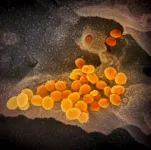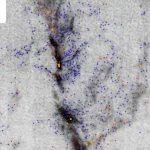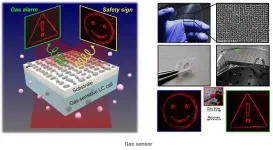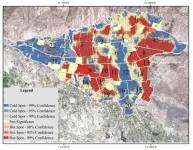Fast radio bursts shown to include lower frequency radio waves than previously detected
New clues discovered in quest to unravel astrophysical mystery
2021-04-16
(Press-News.org) Since fast radio bursts (FRBs) were first discovered over a decade ago, scientists have puzzled over what could be generating these intense flashes of radio waves from outside of our galaxy. In a gradual process of elimination, the field of possible explanations has narrowed as new pieces of information are gathered about FRBs - how long they last, the frequencies of the radio waves detected, and so on.
Now, a team led by McGill University researchers and members of Canada's CHIME Fast Radio Burst collaboration has established that FRBs include radio waves at frequencies lower than ever detected before, a discovery that redraws the boundaries for theoretical astrophysicists trying to put their finger on the source of FRBs.
"We detected fast radio bursts down to 110 MHz where before these bursts were only known to exist down to 300 MHz," explained Ziggy Pleunis, a postdoctoral researcher in McGill's Department of Physics and lead author of the research recently published in the Astrophysical Journal Letters. "This tells us that the region around the source of the bursts must be transparent to low-frequency emission, whereas some theories suggested that all low-frequency emission would be absorbed right away and could never be detected."
The study focussed on an FRB source first detected in 2018 by the CHIME radio telescope in British Columbia. Known as FRB 20180916B, the source has attracted particular attention because of its relative proximity to Earth and the fact that it emits FRBs at regular intervals.
The research team combined the capacities of CHIME with those of another radio telescope, LOFAR, or Low Frequency Array, in the Netherlands. The joint effort not only enabled the detection of the remarkably low FRB frequencies, but also revealed a consistent delay of around three days between the higher frequencies being picked up by CHIME and the lower ones reaching LOFAR.
"This systematic delay rules out explanations for the periodic activity that do not allow for the frequency dependence and thus brings us a few steps closer to understanding the origin of these mysterious bursts," adds co-author Daniele Michilli, also a postdoctoral researcher in the Department of Physics at McGill.
INFORMATION:
About the CHIME Fast Radio Burst Collaboration
CHIME/FRB is a collaboration of over 50 scientists led by the University of British Columbia, McGill University, the University of Toronto, the Perimeter Institute for Theoretical Physics, and the National Research Council of Canada (NRC). The telescope is located in the mountains of British Columbia's Okanagan Valley at the NRC's Dominion Radio Astrophysical Observatory near Penticton. CHIME is an official Square Kilometre Array (SKA) pathfinder facility.
About the paper
Z. Pleunis, D. Michilli, C. G. Bassa, J. W. T. Hessels, et al. 2021. LOFAR Detection of 110-188 MHz Emission and Frequency-Dependent Activity from FRB 20180916B. The Astrophysical Journal Letters. https://doi.org/10.3847/2041-8213/abec72
The research was funded by The Canada Foundation for Innovation and the governments of British Columbia, Ontario and Quebec, with additional funding from the Dunlap Institute for Astronomy and Astrophysics, the Natural Sciences and Engineering Research Council and the Canadian Institute for Advanced Research.
About McGill University
Founded in Montreal, Quebec, in 1821, McGill University is Canada's top ranked medical doctoral university. McGill is consistently ranked as one of the top universities, both nationally and internationally. It is a world-renowned institution of higher learning with research activities spanning two campuses, 11 faculties, 13 professional schools, 300 programs of study and over 40,000 students, including more than 10,200 graduate students. McGill attracts students from over 150 countries around the world, its 12,800 international students making up 31% of the student body. Over half of McGill students claim a first language other than English, including approximately 19% of our students who say French is their mother tongue.
Contact:
Katherine Gombay
McGill Media Relations Office
1-514-717-2289
katherine.gombay@mcgill.ca
http://www.mcgill.ca/newsroom/
http://twitter.com/McGillU
[Attachments] See images for this press release:

ELSE PRESS RELEASES FROM THIS DATE:
2021-04-16
WHAT:
The experimental antiviral drug MK-4482 significantly decreased levels of virus and disease damage in the lungs of hamsters treated for SARS-CoV-2 infection, according to a new study from National Institutes of Health scientists. SARS-CoV-2 is the virus that causes COVID-19. MK-4482, delivered orally, is now in human clinical trials. Remdesivir, an antiviral drug already approved by the U.S. Food and Drug Administration for use against COVID-19, must be provided intravenously, making its use primarily limited to clinical settings.
In their study, published in the journal ...
2021-04-16
Artificial intelligence (AI) has sped up the process of detecting flooded buildings immediately after a large-scale flood, allowing emergency personnel to direct their efforts efficiently. Now, a research group from Tohoku University has created a machine learning (ML) model that uses news media photos to identify flooded buildings accurately within 24 hours of the disaster.
Their research was published in the journal Remote Sensing on April 5, 2021.
"Our model demonstrates how the rapid reporting of news media can speed up and increase the accuracy of damage mapping activities, accelerating ...
2021-04-16
Collaborative research of the University of Jyvaskyla and Natural Research Institute Finland presents new evidence of the effects of enriched rearing on well-being of aquaculture fishes. The research demonstrates that stone enrichments that have been previously conditioned in lake water significantly improve survival of fish compared to clean stones. Also a higher number of stones has a similar positive effect. The results have practical implications for prevention of aquaculture diseases. The study was published in Antibiotics in March 2021.
The volume of aquaculture is continuously increasing. Parasitic diseases represent a significant threat to farmed fishes and ecological solutions to minimize use of medication are being sought.
Enriched rearing, where rearing tanks ...
2021-04-16
A survey of star formation activity in the Orion Nebula Cluster found similar mass distributions for newborn stars and dense gas cores, which may evolve into stars. Counterintuitively, this means that the amount of gas a core accretes as it develops, and not the initial mass of the core, is the key factor in deciding the final mass of the produced star.
The Universe is populated with stars of various masses. Dense cores in clouds of interstellar gas collapse under their own gravity to form stars, but what determines the final mass of the star remains an ...
2021-04-16
Academic medical centers continuously strive to enhance patient care. One of the major mechanisms to improve patient health outcomes is through translational research - bringing research breakthroughs from the lab to patients via clinical trials. Making clinical trials more efficient, and ultimately more successful, would significantly advance patient care. However, fragmentation of the relevant data necessary to implement improvements to translational science is a significant barrier.
While some bioinformatic tools have attempted to address this problem, they often lacked the ability to assess the efficiency of translational science. ...
2021-04-16
Gas accidents such as toxic gas leakage in factories, carbon monoxide leakage of boilers, or toxic gas suffocation during manhole cleaning continue to claim lives and cause injuries. Developing a sensor that can quickly detect toxic gases or biochemicals is still an important issue in public health, environmental monitoring, and military sectors. Recently, a research team at POSTECH has developed an inexpensive, ultra-compact wearable hologram sensor that immediately notifies the user of volatile gas detection.
A joint research team led by Professor Junsuk Rho of departments of mechanical and chemical engineering and Dr. Inki Kim of Department of Mechanical ...
2021-04-16
A person who owns a car or who has a college education may be less vulnerable to COVID-19, according to an analysis of cases in Tehran, Iran, one of the early epicenters of the pandemic. While such variables do not inherently lower a person's risk, they do indicate an infrastructure of protection that persists despite how densely populated a person's district might be.
The international collaboration published their results on April 3 in Sustainable Cities and Society.
"In the past few decades, there have been various efforts aimed at increasing urban density to enhance efficiency and contribute to climate change mitigation -- but the COVID-19 pandemic has brought questions about ...
2021-04-16
The nervous system is the internet of the human body and can in the same way transfer signals over long distances very quickly. Some of the most important elements in this signaling are the axons. They are projections of the nerve cells which send signals to other nerve cells or muscles. For instance, axons that jut out from nerve cells in the spinal cord can be over one meter long.
Researchers from the Faculty of Health and Medical Sciences at the University of Copenhagen have now in a new study examined how signal molecules are transported in ...
2021-04-16
Scientists have called for the use of climate projections in conservation planning, to ensure that areas most at risk from biodiversity loss and climate impacts are protected. Protected areas are often created in areas of low population density and remote locations, rather than because of their biodiversity conservation potential. Conservation planning in tropical forests especially tends to be less rigorous and climate rarely taken into account, they said.
But climate projections and science-based information are critical to actively seek out and safeguard areas where species are most at risk and ecosystems are fast declining, said authors of the ...
2021-04-16
New research has shed light on how autism-spectrum disorder (ASD) manifests in the brains of girls, prompting the scientists to warn that conclusions drawn from studies conducted primarily in boys should not be assumed to hold true for girls.
The researchers discovered that there is a significant difference in the genes and "genetic burden" that underpin the condition in girls and boys. They also identified specific ways the brains of girls with ASD respond differently to social cues such as facial expressions and gestures than do those of girls without ASD.
"This new study provides us with a roadmap for understanding how to better match current and future evidenced-based interventions to underlying ...
LAST 30 PRESS RELEASES:
[Press-News.org] Fast radio bursts shown to include lower frequency radio waves than previously detected
New clues discovered in quest to unravel astrophysical mystery









